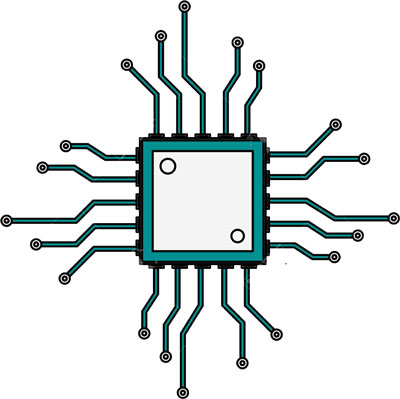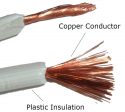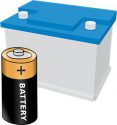 A semiconductor is a material known for its use in the digital world. Most of the electronic devices are based on it. Small devices like a diode, Transistor, and integrated chips (IC) are built from it. These devices are used in computers, games, radio, mobile phones, robots, automatic factories, and many others. The technology around us today is mainly driven by semiconductors.
A semiconductor is a material known for its use in the digital world. Most of the electronic devices are based on it. Small devices like a diode, Transistor, and integrated chips (IC) are built from it. These devices are used in computers, games, radio, mobile phones, robots, automatic factories, and many others. The technology around us today is mainly driven by semiconductors.
What Are Semiconductors?
Semiconductors are placed between a conductor and an insulator. Semi means half and conductor means a material that allows the flow of current. An insulator stops the flow of current. Therefore, a semiconductor is a material that has properties of both conductor and insulator.
The copper conductor allows electric current to pass easily. On the other hand, rubber or wood is an insulator and won’t allow an electric current to pass. But semiconductor materials like Silicon and germanium can be fabricated in such a way that, they can act as both conductor and insulator under certain conditions.
Types of Semiconductors
There are two types of semiconductors: intrinsic and extrinsic. A semiconductor in its normal state is called an intrinsic semiconductor. Intrinsic means which does not contain any addition of external material or impurity.
However, an extrinsic semiconductor contains an addition of other materials to increase its electrical strength. The external material is known as an impurity and the process of adding impurities is known as doping. In the doping process, two different kinds of semiconductors are obtained; one is called N-type, and the other is called P-type material.
Semiconductor Devices
After Doping, the semiconductor materials are combined in layers to make them useful in electronics. N-type and P-type blocks are combined to form different kinds of semiconductor devices. Some of the Semiconductors Devices are diode, transistor, and thyristor.
How Semiconductors Work?
Semiconductors on their own are not that impressive. They become very useful when they are doped and combined to layer to form a semiconductor device. There are many semiconductor devices, but for simplicity, we will take look at 2-layer and 3-layer semiconductors.
2-Layer Semiconductor Working
When a semiconductor device with two layers (combination of N-type and P-type) is given a voltage, it allows the flow of current. The current runs from the N-type block into the P-type block. Hence, it conducts only in one direction. But when voltage polarity is changed, the semiconductor device does not pass the current. This 2-layer and 2-pin device is also known as a diode.
3-Layer Semiconductor Working
Another arrangement can be a 3-layered device i.e. NPN or PNP; Where either two blocks can be N-type with one P-type or two P-type blocks with one N-type. In this case, to start a semiconductor device with 3 layers and 3 pins, the voltage would be applied to the pins of NP and PN blocks. A 3-layer semiconductor device is also called a transistor. You should check our transistor article to understand its working.
Applications of Semiconductors
Semiconductors are widely used in both analog and Digital Electronics. There are a lot of its applications. A few of them are:
- Heating & Cooling – Semiconductors are used in cooling or heating systems like air conditioners, fridges, and various others. A semiconductor device helps the cooling system to monitor and maintain temperature. Similarly, a microwave oven also uses a semiconductor device to create the required heat with the help of a temperature sensor.
- AC / DC Conversion – Semiconductors are also used in battery chargers to convert the AC power into DC power, or DC into AC. For charging a mobile phone or laptop, a charger uses various semiconductor devices to convert household electricity to direct current.
- Electronic Communication – It is also used to raise the strength of the signal. All the communication devices like mobile phones, satellites, radios, walkie-talkies, and antennae use a wide variety of semiconductor devices so that they can communicate at long distances.
- Entertainment – Games and television also use semiconductors. Because when they need to display heavy images with large megapixels, they need to process them faster. So the semiconductor device like transistors and other integrated circuits process them.
- Computers – Computer systems are the major application of semiconductors. Today’s CPUs contain billions of semiconductor devices (transistors) to work faster. It helps them not only to process images but also run a large amount of data.
- Transportation – Smart cars use semiconductor devices to control and monitor their location, speed, and direction.
- Space Exploration – Airplanes, space shuttles, space probes, and Mars Rovers also use a lot of semiconductor devices or chips that help them run their engine, maintain their speed, and track their direction.
History of Semiconductors

Semiconductors were first used in the 1820s. But the first semiconductor device was developed by Karl Ferdinand Braun in 1874 known as the crystal detector – a diode. Later in 1947, John Bardeen, William Shockley, and Walter Brattain invented the transistor at Bell Laboratory.
In 1958, at Bell Lab, an Egyptian engineer Mohamed Attala invented Metal Oxide Semiconductor transistor or MOS transistor. This transistor was faster than the earlier. During the same year, Jack Kilby an engineer at Texas Instruments, and Robert Noyce an engineer at Fairchild Semiconductor invented the first integrated circuit (IC). An integrated circuit may contain various semiconductor devices like diodes and transistors.
By this time, many new types of semiconductor devices began to be developed. Today there are thousands of different semiconductor devices developed for different purposes. Texas Instruments company in the USA is mainly responsible for maintaining the record and datasheets of all semiconductor devices.





